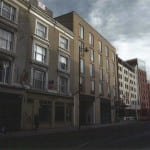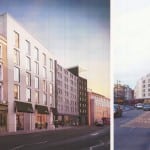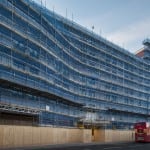- Bed in a room at the Shoreditch outpost of Ace Hotels
- Architectural drawings of the new block following construction at the Ace Hotel.
- The previous Crown Plaza, far right.
- Drawings of the new Ace Hotel, right.
- The Ace Hotel under construction.
London’s next hotel boom is underway in the trendy neighbourhood of Shoreditch, which lies on the border of the City of London and its historic East End.
Six high-profile boutique properties will open in Shoreditch over the next 24 months, led by the Ace Hotel‘s first property outside the United States. The spate of new hotels marks a shift in traveller interest from the usual London attractions of the West End to the grittier — and hipper — environs of the city’s east.
“All the hotel operators moving in to the area say that their target demographic, the 18 to 45 age-group, no longer want to stay in the West End,” said Andrew Sissons, the head of regeneration projects at Hackney Council, the local authority in Shoreditch. “St Paul’s, Westminster Abbey, Selfridge’s — that’s not what they want anymore.”
Ace Hotel Digs In
Ace Hotel London Shoreditch (a bit of a mouthful, surely) will open its 265 rooms in September on the site of a former Crowne Plaza.
“We want the hotel to be a living part of the community and linked to the local culture,” said Ace co-founder Alex Calderwood by e-mail.
True to his word, Calderwood is shedding the Americana and loading up on British brands for the London hotel. The lobby will feature a cafe by London favourite Square Mile Coffee Roasters. The acclaimed duo of David Waddington and Pablo Flack of the nearby eatery Bistrotheque will run a juice bar called Lovage, along with a restaurant and bar. They will also serve food through a take-away window that opens to the street. Local florist Hattie Fox, who planted Wimbledon’s VIP area this year, will run a flower shop in the lobby.
The Britishness doesn’t end there. Guests can tune in to the BBC on British Revo radios and leave their loose change on a “custom change tray” by noted bag designer Ally Capellino. Staff will sport clothing designed by heritage brands John Smedley and Gloverall. The hotel will also rent bicycles supplied by hip Japanese brand Tokyobike, which has an outpost in the neighborhood, from its front desk.
Ace has hired Universal Design Studio, which made its name designing Damian Hirst’s Pharmacy bar, to deliver a “warehouse aesthetic” that’s in line with the area’s historic architecture, according to plans filed with the local council. The building’s existing facade will be stripped of “fussiness”, including elements like timber cladding and “cheap” rainwater pipes, and replaced with custom brickwork and a special “textured render coat” in shades of grey.
The hotel has made provisions to hire 180 staff, up from the 80 the Crowne Plaza used to employ, according to the plans.
Laurent Vernhes, who started bookings site Tablet Hotels, says the Ace London will be a test of the group’s ability to manage its recent expansions. As Vernhes sees it, the hotel group’s ambitious plans for Los Angeles, where it’s opening a 269-room property this year, and London might stretch it too thin. Ace properties are available on Tablet Hotels.
“Everything they’ve done so far was done very slowly; now they are accelerating. Can they accelerate and maintain this ethos? Can they scale at the speed that they’re doing now?” Vernhes says.
Shoreditch Hotel Boom
Ace is the first in a series of high-profile hotel openings in Shoreditch. The six properties slated to open will add about a 1,000 rooms to the area’s hotel supply. Among them is the first European Nobu hotel, a second London outpost for Dutch boutique chain CitizenM and a new property by local group Montcalm.
Shoreditch has slowly gained traction with hoteliers since the Crowne Plaza became the first hotel to open in the area in 2004. Down the road is The Boundary, a luxurious 17-room boutique opened by designer Terence Conran in 2008.
The Boundary’s general manager, Tim Holloway, says he’s raised room rates every year as demand from his mainly American business traveller clientele has increased.
“We’ve steadily increased rates over the years. Our average (nightly) room rate was 190 pounds three years ago and now it’s about 260 pounds,” he says.
Local Gentrification and Global Travel
Shoreditch’s rise is an example of local gentrification’s impact on global travel. The area started gaining currency in the 90s when the Young British Artists — people like Tracy Emin and Damien Hirst — started using hollowed out workrooms and warehouses that as studios and apartments, says Alex Rhys-Taylor, a local resident and deputy director of the Centre for Urban Research at Goldsmiths University.
Then street artists like Banksy started decorating the area’s brick walls and advertising agencies began using warehouses as offices. Shoreditch’s rebirth as a global trend-setting spot was in full swing.
“Shoreditch is really on a network of tourist destinations that include particular neighborhoods in Berlin, Silver Lake in Los Angeles, Williamsburg in Brooklyn,” says Rhys-Taylor. “If there’s an Ace Hotel in your neighborhood for example, you are quite likely to visit other neighborhoods that have Ace Hotels in them.”
Street artist and Banksy collaborator Pure Evil, who owns an eponymous gallery in the neighborhood, says Shoreditch has long passed peak cool.
“It’s probably peaked to the point where it’s so incredibly, crushingly, hip that the hipsters are denying that it’s hip,” Pure Evil, who also goes by Charles Uzzell Edwards, says.
Not that Pure Evil is complaining. For business owners like him, Shoreditch’s booming tourist economy means a shot at growing revenues. Area hotels and restaurants hang his pieces on their walls — even the Ace Hotel has been in touch. Today, tour companies give visitors walking tours of the area’s street art.
“A lot of international tourists come here and they want to make a visit to the gallery part of ‘their trip to Shoreditch’ and that’s brilliant. We have street art maps for them,” he says.
For all of Shoreditch’s tourist-friendly new vibe, however, it’s still a long way from the stereotypical image of a London vacation that’s still promoted by globally: Beefeaters in furry hats, immaculate Georgian townhouses and high-street shopping on Oxford Street in London’s West End.
“People aren’t walking around with sweaters over their shoulders here,” Pure Evil says. “There are still abandoned buildings you can walk into and there are certain areas where gentrification hasn’t happened.”
Have a confidential tip for Skift? Get in touch




